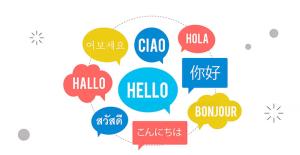People have been asking this question for a long time and trying to answer why people speak different languages.
You probably already know the legend of the Tower of Babel . In the Bible, the story of the Tower of Babel tells that in the beginning man spoke only one language, but God was angry when man purposely built a tower to try to climb to heaven and God did not want that. So God made people speak different languages and scattered them all over the Earth.

There are many explanations for why there are many languages, and each is partly true.
The Absaroka natives of America have another story that tells of an old coyote that created the human race. At first, these people spoke the same language, but later a young wolf told the old wolf that humans are very good at creating conflicts and wars and it convinced the old wolf to make people talk about many things. different languages to let people misunderstand each other and thus fight each other and show off their talents.
There is another story of the Jawoyn people of Northern Australia. Here it is believed that wherever the crocodile Nabilil goes, it names the land and creates a language of its own for the people there to speak.
And there are many other similar stories around the world.
More recently, linguists have attempted to answer this question. Truth be told, we may never know the origins of languages, but we do know quite well the differences between languages and how they change. Interestingly, there is also something true in the fairy tales, legends of castles, wolves and crocodiles told above.
In the story of the Tower of Babel, God makes people go around the world. In fact, from archaeological excavations we know that humans have migrated thousands of years ago to different lands.
So what you need to create different languages are three magic ingredients: time, distance, and language transformation processes. So when people who speak the same language break up and go to different places, over time that language can become 2 or more other languages.
Let’s take Latin as an example. As Latin speakers migrated across Europe, their languages gradually mutated into French, Spanish, Italian and Portuguese, making the original Latin language not a dead language but evolving. into many languages today.
English is another example. In the 15th century, Germanic tribes including the Angles, Saxons and Jutes left their homeland in Europe to invade England. The Germanic dialects they brought with them developed into Old English.
The story of the coyote Absaroka is about language differences that lead people to speak different languages to misunderstand or disagree with each other. Voice is often associated with the identity of each person. Along with going to different regions, identity is another thing that can transform a language or become a new language.
For example, in a village in Papua New Guinea, everyone speaks the same language, Selepet, and people in neighboring villages also speak this language. However, the people in a certain village decided to change the way they say “no”. In this way, their word “no” turns into “bunge” rather than the standard Selepet language “beer” and people can recognize this villager when they say the word “bunge”.
Take a look at the locality where you live and the neighboring provinces. The coyote factor is one of the motivations for people in each region to promote their identity through language.
So does any language eventually split into many other languages as is the case with Latin? Probably not. The problem is that we don’t live in isolation like people in the past. We talk to each other often, face-to-face, on the phone, on the computer, and in many other ways that keep us close.
The story of the crocodile, Nabilil, is about the evolution of language in close relation to its surroundings and the naming of new lands, new animals and new experiences.
We can see this clearly in the emigration of the British to Australia. When the British arrived in Australia, English had existed for more than 800 years. However, the English-speaking settlers at the time did not have the words to describe Australia. They either borrowed words from Indigenous Australians (e.g. kangaroo, wombat) or created new meanings for old words (e.g. magpie, possum), both of which are derived from the names of animals that were originally meant to be used. available in Europe and America.
Or as in Vietnamese, we have a lot of French loan words, especially to refer to parts of bicycles and cars because these vehicles were brought into Vietnam by the French, for example: pe dan – pedale, handlebar – guidon, steering wheel – volant, car – auto, etc. Another example of loanwords between languages is that the word “dàpô” in Vietnamese is equivalent to “typhoon” in Vietnamese. English and “taifeng” in Chinese.
Like humans, language is always evolving and that’s why we have so many languages , and one way to avoid the coyote’s curse is that we should learn to speak some things. language, not just their mother tongue.

